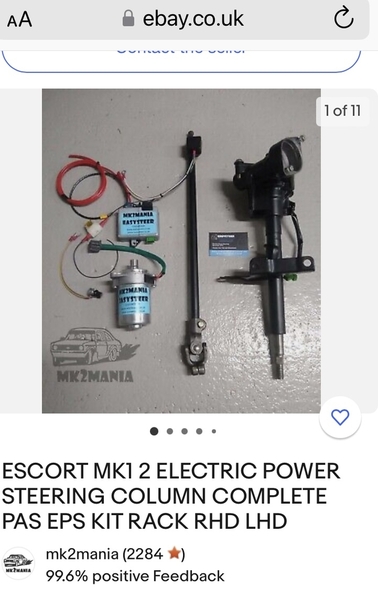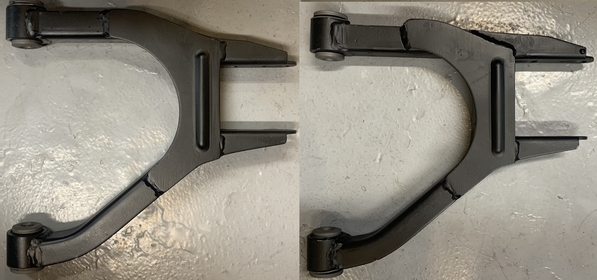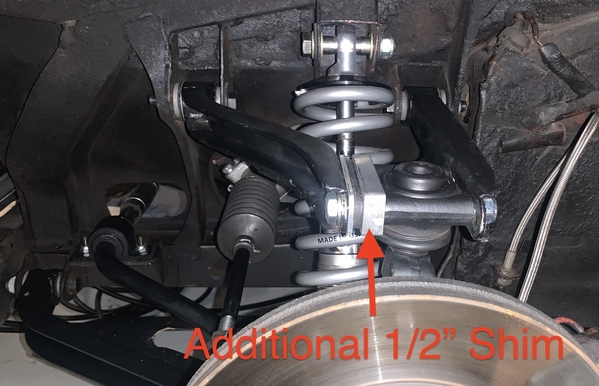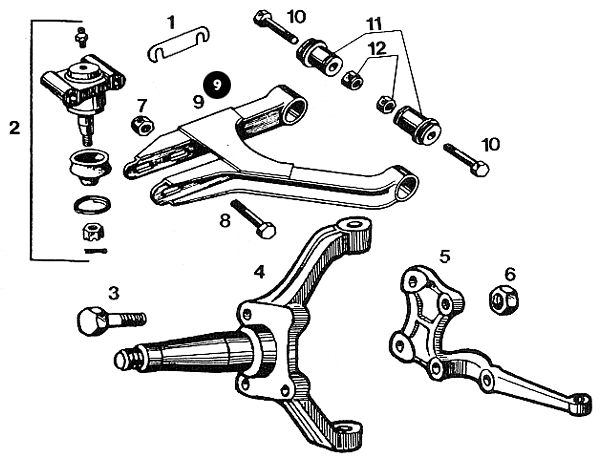For those of you who are using the SACC EPS kit (electric power steering), does it return to center by itself? (self center)
Replies sorted oldest to newest
I can't answer your question directly but I can tell you about my experience with my EZ Electric PS system. Prior to installation, EZ told me to expect a slight decrease in self-centering with their system and that a small increase in caster would return the original self centering effect. After installation, I noticed no decrease in self centering, in spite of being aware and paying attention every time I turned the wheel.
If you want to find out about the SACC system specifically, I'm sure someone here will chime in. If you're considering a purchase, perhaps Gerry Romack (glpanteraclub@gmail.com) would be a good person to talk to. He's driven multiple Panteras with both systems installed (SACC and EZ Electric) and says they feel quite different. I believe he's installed both systems too. No, Gerry hasn't installed PS on his "one of two four in the USA" Pantera Si !
David, I know of four Si's in the US!
Julian,
I was unaware of that. I stand corrected !
@davidnunn posted:I can't answer your question directly but I can tell you about my experience with my EZ Electric PS system. Prior to installation, EZ told me to expect a slight decrease in self-centering with their system and that a small increase in caster would return the original self centering effect. After installation, I noticed no decrease in self centering, in spite of being aware and paying attention every time I turned the wheel.
If you want to find out about the SACC system specifically, I'm sure someone here will chime in. If you're considering a purchase, perhaps Gerry Romack (glpanteraclub@gmail.com) would be a good person to talk to. He's driven multiple Panteras with both systems installed (SACC and EZ Electric) and says they feel quite different. I believe he's installed both systems too. No, Gerry hasn't installed PS on his "one of two four in the USA" Pantera Si !
I am considering EPS. In doing my investigating I have come across the comment that the largest "issue", for lack of a better term is that none of them seem to self center.
SO FAR, the "street rodders, or 'hot rodders' " are my best source of information. After all, these guys have gone through countless applications. Experience counts and I will say that negative experiences shouldn't be disqualifying at this point
Consider that BOTH EZ and SACC are essentially "hot rodding" existing EPS units not specifically made for a Pantera application. I do not mean that in a derogatory way. They both more correctly are "re-engineering" an application but both are "stuck" with the qualities of the products they selected to apply.
The biggest issue that I can see is fitting the EPS unit into the available space in the Pantera. SACC has taken a slightly different approach in machining there own column. Apparently EZ has taken a similar approach but in one posted picture they are clearly showing a BMW column top and cover with an angled ignition switch.
One of the fixes or admissions that the unit is not self centering is stating a fix of dialing in more + caster. In American vehicles power steering is one way of getting the effect of greater straight line stability at speed.
I'm looking at gaining high speed stability (going straight) at high speed without using excessive + caster, but still running into a complete lack of candor on the operation of these systems.
From my investigation, across the board, the power assist gained is in the area of 4:1. The dampening effect of the road shock as a result has got to be substantial and it has got to calm down that steering wheel giggling that you get with a wide body car modification.
No decisions have been made by me at all. I'm still in the investigation stages. I'm just picking your brains at this point but I haven't lost interest in this...yet.
Yes I would love to get feedback on this subject (self centering) for EPS equipped Panteras. Wasn't there a group buy of 25 from the Michigan chapter?
I have the SACC kit and I can say it's one of the best things I've done to the car. The car feels more modern and just more enjoyable to drive. I looked at the EZ kit too, but it seemed like Scott's was more designed for the Pantera specifically. It wasn't an easy install but wasn't as hard as other jobs I'd say. Just make sure you have a solid workbench. But the ability to calibrate it instantaneously is terrific, as I like to turn it up when I'm parking or having to back in to a spot, and it's like a modern car.
As for the OP's question, I've never thought about the self-centering, never been an issue with it. I'll take it out tomorrow and see what I notice.
Also, one added bonus was that the wheel and whole column is soooo much more solid and secure now.
Doug,
You wrote "Apparently EZ has taken a similar approach but in one posted picture they are clearly showing a BMW column top and cover with an angled ignition switch.".
That's my steering column. I installed a GT5-S ignition assy. but the OEM GT5-S column covers fit so badly, I made my own. Because my system was the first one, that's what they took photos of.
EZ Electric also supplies an entire, new column.
EZ Electric has a relationship with an OEM manufacturer of EPAS motors. The company supplies many auto manufacturers with their EPAS units. When EZ Electric decides to install PS, they have many motor options to choose from. They consider the weight of the vehicle, the weight distribution and packaging. They have even received TÜV approval for their Pantera system in Germany. After installing the system in my Pantera, I can assure you, the steering feels no different than before. It's still Pantera steering but lighter in parking maneuvers.
I've seen David's car and his steering column cover is very nice. It stands out for sure, in a good way. It's too bad that it's not part of the EZ package.
@davidnunn, Dave, do you know what the speed to power assist ratio is on your EZ unit? 0-XXmph = 100-0% assist. I think that is a big benefit over the SACC unit. At speed you would have full road feel. I want an EZ unit but it's down the list of priorities at the moment.
Steve
Although I have not seen actual “official” confirmation, the source for the EPAS system used in the SACC kit is the Renault Clio.
The Clio, introduced in 2019, is a compact, three cylinder, front wheel drive car with a curb weight of 2600 pounds. That is 400 to 500 pounds lighter than most Panteras.
The Pantera F to R weight bias is about 40/60. That puts about 1200 pounds on the front axle.
One could assume the front wheel drive Clio carries more weight on the front axle than the rear, but even if it was somehow 50/50 it would be putting 1300 pounds on the front axle. Only 100 pounds more than the Pantera.
I don’t know what OEM unit is used by EZ, but surely it comes from a modern car similar to the Clio.
Bottom line here is I don’t think there are any weight-based shortcomings regarding the safety of installing these units in our Panteras.
I have the SACC unit from Scott and I love it. I have found a single setting that provides ease of parking maneuvering and good road feel. Spirited driving on a twisty/turny road still has the same joy factor without the tiring physical effort.
Larry
Steve,
I would guess that all of my assist is gone by about 40 mph or less. That being said, even at 20mph, my steering feels exactly as it did before. People assume you lose road feel when you have assist but that's not the case. You always have normal road feel with the EZ PS system. The transition from assist to no assist happens so gradually and seamlessly, you really pay no attention to it. Even with full assist, it always feels like it did before, just lighter. I think it's perfect the way it comes out of the box but if you wanted the assist to stay in longer or be gone sooner, you could do that quite easily. In fact my plan was to modify the VSS in order to have the assist phase out sooner. Then I drove it and immediately decided that would be a complete waste of time and effort!
I do have one criticism of the EZ Electric system. The VSS they supply is an ugly, horrible looking thing but they refuse to just leave it out. It belongs in the trash. Milwaukee Speedometer Service has a very nice VSS that replaces the angle drive unit on our ZF's. When you're ready, I'll give you the specifics.
Dave
Good feedback so far. Considering other applications I've investigated I'm pleasantly surprised that there is absolutely no negative feedback on the self centering question that I raised?
Larry, EZ states that they are using one of two Japanese suppliers of the motor assembly. Yes you can get either to sell you a new one but the issue is they don't want to sell you just one.
It's very difficult to tell exactly which unit EZ or SACC is using but working on this for about 4 years now, on and off, both units resemble very closely the Toyota Versa. SACC's pictures may be of an earlier model since the location of the electronics cover plate is on the right/driver's side, not on the top left like the Versa's.
What IS significant is that the Japanese units will work without the control box, just three wire hook up. The go into a safe mode and provide a "steady 43 mph" boost.
The only reason I see for the control box is to ramp down boost as speed increases but you need a VSS for that to work.
The Renault that I am seeing looks larger but I will admit that it is difficult to know the size details exactly without having them in front of you. The Prius is the same size as the Versa but the motor is oriented on the right side. It is so tight under the dash that is a significant factor. The motor needs to go on the left side.
They all look small until you trial fit one into a Pantera. Even the ATV's are too large to fit easily.
It's also interesting that you guys ARE using the potentiometer where Scott remarked that he didn't feel he needed to adjust it at all. It "felt fine to him left on full". Knowing him I feel safe in assuming that he tested it at excessive speed.
I'm just review everyone's remarks here. Not criticizing it at all. I guess I was always the PITA in the class either openly or secretly questioning authority? Some things will never change. A Pantera is kind of a rebels car even in a group of non-conformists?
Doug,
It's doubtful the SACC and EZ PS kits use the same EPAS motor as I'm told by Gerry Romack, who's driven Panteras equipped with both, that the systems feel VERY different.
That information apparently is proprietary. It isn't just the Pantera with EPS kits, it's "universal kits" and specific kits for virtually everything out there including farm tractors.
It really has become somewhat of a "cottage industry" that when it comes down to it, you can build it yourself in your own little cottage. That probably is the reason for this secretive attitude seemingly across the board.
I love the threats from the kit sellers. Nice touch.
Talking about "Big Brother", the entire Western European "DMV" situation is obscene. I couldn't exist in that kind of a reality.
Maybe my Pantera is my version of a '32 Ford streetrod?
That was weird ! If you want to do it yourself, check out DC Electronics in the UK.
Attachments
Did you mean DC Comics?
@lf-tp2511 posted:
Why build your own when you can get someone else to? Nice find Larry. Does is self center?
Look at that effin' taper on the shaft! ![]()
@panteradoug posted:For those of you who are using the SACC EPS kit (electric power steering), does it return to center by itself? (self center)
The Pantera itself is self centering due to its positive caster geometry. If the SACC kit was also self centering then the two would fight each other. It seems like it would be impossible to get them to genuinely synchronize and to stay that way.
@stevebuchanan posted:The Pantera itself is self centering due to its positive caster geometry. If the SACC kit was also self centering then the two would fight each other. It seems like it would be impossible to get them to genuinely synchronize and to stay that way.
So Steve, you have no issues with the steering self centering using the SAAC kit?
Doug, I don't have the SACC kit yet. I preordered it and should have it in April. Currently, my 74 Euro Pantera that the kit is destined for does not self center well. Other Panteras have self centered better. I am just finishing up with installing modified upper front a-arms to significantly increase positive caster. It will be interesting to drive the car and hopefully experience improved self centering before power steering is added. I have been describing this on another current posting:
Attachments
Looks good. Good engineering thought process.
I'm not sure how much positive caster you can dial in without significant fender/tire interference.
I'm concerned with the big delay to deliver the kit from SACC as well as thinking there is a smaller, more compact EPS unit that they can use?
This is a good time of the year for me to consider a project like this. It likely will be at least April before the car is on the road because of the weather conditions anyway.
Even LA is getting washed away. Not even a good time for boats...and you can't even be guaranteed your flight will get off at all or even close to being on time.
Nope. Garage time it is!![]()
Steve,
With your upper control arm mods, how much caster do you have with the upper ball joints fully to the rear?
Steve,
Is the upper control arm in the picture upside down, on the wrong side of the car? Shouldn't the plate be on the top?
Steve
Attachments
@davidnunn posted:Steve,
With your upper control arm mods, how much caster do you have with the upper ball joints fully to the rear?
I will be measuring the maximum positive caster angle today or tomorrow. Before the modification it was slightly less than 2 3/4 degrees.
Moving the upper ball joint towards the rear will also offset the wheel towards the rear so the wheel will no longer be centered in the fender opening (assuming it was in the first place). How much offset depends on several things. This may or may not cause clearance issues or aesthetic consequences. People have mentioned offset bushings for caster adjustments. If they are available, that is a good option to offset the lower control arm forward. We built custom upper adjustable control arms and modified the lower control arms to get the caster adjustability I wanted with keeping the wheels centered to the body. Attached is a very crude sketch to illustrate the point. I am not suggesting that the upper joint mod shouldn't be done, just sharing for the few that may not know this.
Attachments
The offset bushings would be the simplest way to accomplish the increase caster but have disappeared from the common sources.
I would go for a set if I could find them.
Doug,
I missed your question: "Wasn't there a group buy of 25 from the Michigan chapter?". Not sure if it was 25 but yes, there was a group buy of EZ Electric PS systems but it was the Great Lakes POCA Chapter. Gerry Romack (glpanteraclub@gmail.com) arranged it. In fact, I think they've done more than one group buy of EZ systems.
I don't think any of them have chimed in here. I like to get feedback from as many as I can. Everyone has a little different experience and notices slightly different things.
I will say though David, that the EZ uses a VSS and the SACC does not as far as I see or I mistaken on that?
EZ uses either a VSS or a potentiometer; it’s up to the customer. Naturally it’s less expensive with a potentiometer, but not a lot cheaper. The VSS they supply goes between the angle drive on the ZF and the speedo cable. SACC only supplies their system with a potentiometer.
As I mentioned in a previous posting, the only person I know of that has experience with both systems is Gerry Romack. I’m sure he would be happy to reply to an e-mail asking for a comparison of the two systems.
The Japanese units, made by Koyo or NSK, have a fail safe built into the basic motor device that will go to what was programed into that chip as the assist necessary for 43mph.
For those you only need a three wire hook up for "basic operation". The 10 gauge black (-), red (+) and the white wire to the ignition switch "run position".
IF you want to dial down the assist automatically as speed increases, then you need the separate brain, i.e., the little separate box. It's only purpose is to dial down the boost according to vehicle speed.
I'm not sure why SACC uses the box unless the EPS CPU sees the potentiometer the same way as it sees the VSS?
The US GM versions will not operate without that original CPU box or the little aftermarket "patch in" box that fools the EPS motor.
I'll email Gerry Romack. I'm enjoying this discussion. It's fun and informative.
Typically with the 'Johnny Woods' A-Arm mod you are going to have 3/4" of spacers total, if all in front of the ball joint it's about 7.5 degrees of caster which is ideal for a wide body car. The narrow body benefits most from 5 degrees which can usually be achieved with the 1/2 spacer in front and 1/4 " to the rear of the ball joint.
I plan to start with the 3/4" shims and try to get a feel for better centering of the car. I am actually looking forward to having a heavy feel of the steering wheel. Prior to this the steering wheel turned with very little effort and the car has not returned to center very well. Thus I will start with the maximum positive caster and then rearrange the shims for less positive caster as needed. I have a nice assortment of shims to work with. My plan is to measure the degrees of caster from the start to finish of this endeavor.
With an EPS, I'm not sure there is value to a lot of caster. My 73 (4460) is still stock caster (maxed out) and has a nice feel of not fighting you to return to center.
As a matter of fact because of that I'm not sure EPS is worth the effort unless the car is a wide body?
I'm probably used to the feel of an American PS car and not seeing the difference?` I realize this may be a 180° wrong thought but am still working this out in my head.
Anyone want to loan me theirs for extensive side by side testing? I'll be gentler then the car magazines? I mark 7,000 rpm's on the tack with a yellow crayon so there are no issues. ![]()
Greater high speed stability isn’t the only reason to increase caster. It also improves turn-in and makes the car feel more nimble. The penalty is increased steering effort. Most contemporary sports cars run 5-1/2° or 6°. In fact, the Pantera’s front suspension was designed for these levels of caster but Ford thought the steering effort was too high, so caster was reduced accordingly.
Do the very early cars have provisions for increased caster? Racecarmikes comments about moving both the upper and lower suspension arms equally opposite to center the wheel is well taken.
Hey Doug, If you want to finish putting my 5715 together, you can borrow it. Redline is 6500 though.![]()
@davidnunn posted:Steve,
With your upper control arm mods, how much caster do you have with the upper ball joints fully to the rear?
With the the ball joints fully shimmed to the rear and the car on the ground, I am reading 6.25 degrees positive caster.
A little more about caster. Mostly cut and paste but slightly embellished by me.
"Caster:
The steering axis is angled such that a line drawn through it intersects the road surface slightly ahead of the center of the contact patch of the tire on the pavement by a distance called trail. The purpose of this is to provide a degree of self-centering for the steering—the wheel casters around in order to trail behind the axis of steering. This makes a vehicle easier to control and improves its directional stability (reducing its tendency to wander). Excessive caster angle will make the steering heavier and less responsive, although in racing large caster angles are used for improving camber gain in cornering. Caster angles over 7 degrees with radial tires are common. Power steering is usually necessary to overcome the jacking effect from the high caster angle.
The steering axis does not have to pass through the center of the wheel, so the caster can be set independently of the trail, which is the distance between where the steering axis intersects the ground, in side view, and the point directly below the axle.
Caster angle and trail both influence the steering, albeit in different ways: caster tends to add damping, while trail adds "feel" and returnability (to self-center)."
Take particular note of the last sentence.
I revised my very crude sketch to show the trail (which will vary depending on tire size and other design aspects) to illustrate how that can vary depending on how caster is added. The red car on the right side of the sketch (very simplified) shows some things we experimented with on our race cars. I don't have the drawing here so the dimensions are arbitrary just to illustrate the point. Design "B" worked OK but required lots of arm strength and was overly sensitive to steering inputs. For "C" and "D" I redesigned the front uprights from a forward spindle design to a trailing spindle design. That tamed the beast. The car was no longer overly sensitive to steering inputs and I didn't need to take Advil after the race. I was ready to install power steering before the change. The lap times improved, mostly because the car was much easier to drive.
Mike
Attachments
@racecarmike posted:Hey Doug, If you want to finish putting my 5715 together, you can borrow it. Redline is 6500 though.
![]()









